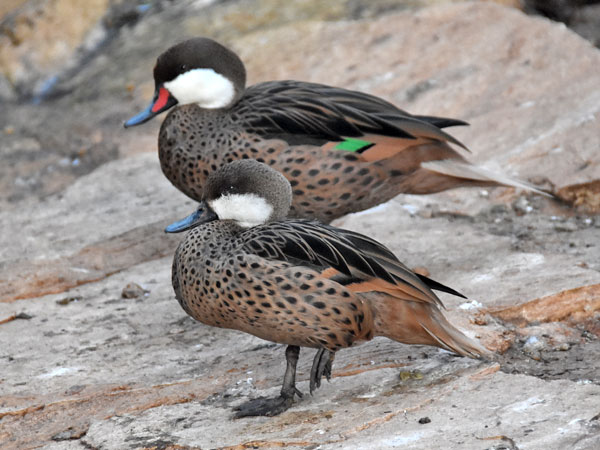White-cheeked Pintail

Scientific Name
Anas bahamensis
Alternative Names
Bahama pintail, Bahama duck, White-cheeked duck
Measurements
| Feature | Male | Female |
|---|---|---|
| Body Length | 38–51 cm | 38–51 cm |
| Weight | 474–710 g | 505–670 g |
| Wingspan | Around 76–84 cm | Around 76–84 cm |
Status
Listed as Least Concern, though some local populations face pressure from habitat loss and hunting.
Identification
A medium-sized dabbling duck with brown mottled plumage, distinct white cheeks, and a grey bill with a red base. Both sexes look similar, with females slightly duller. The speculum shows an iridescent green sheen. Tail feathers are pointed but less pronounced than in the Northern Pintail. Juveniles have duller plumage and a less colorful bill.
Voice
Soft, high-pitched whistles from males, especially during courtship. Females produce a quieter, rasping quack.
Diet
Feeds by dabbling in shallow water. Eats aquatic plants, grass seeds, algae, insects, small aquatic invertebrates, and occasionally small crustaceans.
Distribution
Found in the Caribbean, northern and southern parts of South America, and the Galápagos Islands.
Habitat
Prefers shallow wetlands, brackish lagoons, mangrove swamps, estuaries, and freshwater pools. Often seen in coastal lowlands but can also occur in higher elevations up to 2,550 m, especially in the rubrirostris subspecies.
Breeding
Nests on the ground, hidden in vegetation close to water. The nest is a shallow scrape lined with down. Clutches typically contain 6–10 eggs. Both parents guard the young, but incubation is mainly by the female.
Wintering
This species is mostly resident and does not undertake long migrations. Some individuals make local movements in response to rainfall or changing water conditions.
Conservation
Overall numbers are stable, but wetland drainage, habitat disturbance, and hunting pose local threats. Protection of wetlands and control of hunting help safeguard populations. Subspecies on the Galápagos Islands are of special concern due to their limited range.
